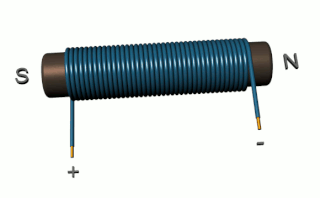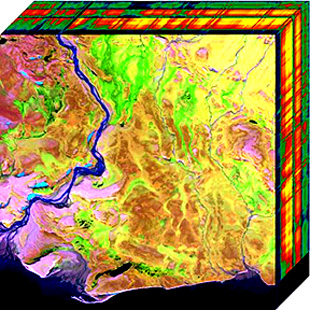Related Research Articles

Condensed matter physics is the field of physics that deals with the macroscopic and microscopic physical properties of matter, especially the solid and liquid phases that arise from electromagnetic forces between atoms and electrons. More generally, the subject deals with condensed phases of matter: systems of many constituents with strong interactions among them. More exotic condensed phases include the superconducting phase exhibited by certain materials at extremely low cryogenic temperatures, the ferromagnetic and antiferromagnetic phases of spins on crystal lattices of atoms, the Bose–Einstein condensates found in ultracold atomic systems, and liquid crystals. Condensed matter physicists seek to understand the behavior of these phases by experiments to measure various material properties, and by applying the physical laws of quantum mechanics, electromagnetism, statistical mechanics, and other physics theories to develop mathematical models and predict the properties of extremely large groups of atoms.
An off-axis optical system is an optical system in which the optical axis of the aperture is not coincident with the mechanical center of the aperture. The principal applications of off-axis optical systems are to avoid obstruction of the primary aperture by secondary optical elements, instrument packages, or sensors, and to provide ready access to instrument packages or sensors at the focus. The engineering tradeoff of an off-axis optical system is an increase in image aberrations.

An electromagnet is a type of magnet in which the magnetic field is produced by an electric current. Electromagnets usually consist of wire wound into a coil. A current through the wire creates a magnetic field which is concentrated in the hole in the center of the coil. The magnetic field disappears when the current is turned off. The wire turns are often wound around a magnetic core made from a ferromagnetic or ferrimagnetic material such as iron; the magnetic core concentrates the magnetic flux and makes a more powerful magnet.
The Faraday effect or Faraday rotation, sometimes referred to as the magneto-optic Faraday effect (MOFE), is a physical magneto-optical phenomenon. The Faraday effect causes a polarization rotation which is proportional to the projection of the magnetic field along the direction of the light propagation. Formally, it is a special case of gyroelectromagnetism obtained when the dielectric permittivity tensor is diagonal. This effect occurs in most optically transparent dielectric materials under the influence of magnetic fields.

A metamaterial is any material engineered to have a property that is rarely observed in naturally occurring materials. They are made from assemblies of multiple elements fashioned from composite materials such as metals and plastics. These materials are usually arranged in repeating patterns, at scales that are smaller than the wavelengths of the phenomena they influence. Metamaterials derive their properties not from the properties of the base materials, but from their newly designed structures. Their precise shape, geometry, size, orientation and arrangement gives them their smart properties capable of manipulating electromagnetic waves: by blocking, absorbing, enhancing, or bending waves, to achieve benefits that go beyond what is possible with conventional materials.
Super-resolution imaging (SR) is a class of techniques that enhance (increase) the resolution of an imaging system. In optical SR the diffraction limit of systems is transcended, while in geometrical SR the resolution of digital imaging sensors is enhanced.

Zinc telluride is a binary chemical compound with the formula ZnTe. This solid is a semiconductor material with a direct band gap of 2.26 eV. It is usually a p-type semiconductor. Its crystal structure is cubic, like that for sphalerite and diamond.

Hyperspectral imaging collects and processes information from across the electromagnetic spectrum. The goal of hyperspectral imaging is to obtain the spectrum for each pixel in the image of a scene, with the purpose of finding objects, identifying materials, or detecting processes. There are three general types of spectral imagers. There are push broom scanners and the related whisk broom scanners, which read images over time, band sequential scanners, which acquire images of an area at different wavelengths, and snapshot hyperspectral imagers, which uses a staring array to generate an image in an instant.
The Electro-Optical Systems Laboratory is one of eight labs in the Georgia Tech Research Institute and one of three labs under the Electronics, Optics, and Systems directorate. It conducts basic and applied research into electro-optical topics and supports electro-optical education at the university level.
In physics, photon-induced electric field poling is a phenomenon whereby a pattern of local electric field orientations can be encoded in a suitable ferroelectric material, such as perovskite. The resulting encoded material is conceptually similar to the pattern of magnetic field orientations within the magnetic domains of a ferromagnet, and thus may be considered as a possible technology for computer storage media. The encoded regions are optically active and thus may be "read out" optically.
Electro-optical MASINT is a subdiscipline of Measurement and Signature Intelligence, (MASINT) and refers to intelligence gathering activities which bring together disparate elements that do not fit within the definitions of Signals Intelligence (SIGINT), Imagery Intelligence (IMINT), or Human Intelligence (HUMINT).

The Parker Solar Probe is a NASA space probe launched in 2018 with the mission of making observations of the outer corona of the Sun. It will approach to within 9.86 solar radii from the center of the Sun, and by 2025 will travel, at closest approach, as fast as 690,000 km/h (430,000 mph) or 191 km/s, which is 0.064% the speed of light. It is the fastest object ever built.
Spectral Sciences Incorporated (SSI) is a research and development company, located in Burlington, Massachusetts, United States.

A photonic metamaterial (PM), also known as an optical metamaterial, is a type of electromagnetic metamaterial, that interacts with light, covering terahertz (THz), infrared (IR) or visible wavelengths. The materials employ a periodic, cellular structure.

The history of metamaterials begins with artificial dielectrics in microwave engineering as it developed just after World War II. Yet, there are seminal explorations of artificial materials for manipulating electromagnetic waves at the end of the 19th century. Hence, the history of metamaterials is essentially a history of developing certain types of manufactured materials, which interact at radio frequency, microwave, and later optical frequencies.
PRISMA is an Italian Space Agency pre-operational and technology demonstrator mission focused on the development and delivery of hyperspectral products and the qualification of the hyperspectral payload in space.

HySIS is an Earth observation satellite which will provide hyperspectral imaging services to India for a range of applications in agriculture, forestry and in the assessment of geography such as coastal zones and inland waterways The data will also be accessible to India's defence forces.
Sasikanth Manipatruni is an American engineer and inventor in the fields of Computer engineering, Integrated circuit technology, Materials Engineering and semiconductor device fabrication. Manipatruni contributed to developments in silicon photonics, spintronics and quantum materials.

Michael Theodore Eismann is an American scientist and researcher working at the Air Force Research Laboratory. He is a former editor of Optical Engineering and a member of the NATO Sensors and Electronics Technology panel. In 2023, Eismann was elevated to fellow membership of the IEEE.
References
- ↑ Rivera, Michael; Buchanan, Jonathan J.; Morales, Anibal (14 November 2011). "Physics-Based Performance Analysis with High Fidelity, Dynamic, Real-Time EO Scene Generation" (PDF). Archived (PDF) from the original on 13 November 2018. Retrieved 14 November 2018.
- ↑ Sun, Qiang; Tang, Tong-bin; Dong, Guo-cai; Wang, Jian (June 2007). "Design of the diffractive/refractive optical system in optical collimator of infrared scene generator". CNKI. Archived from the original on 12 March 2013. Retrieved 14 November 2014.
- ↑ Nelson, Neil R.; Bryant, Paul Tristan; Sundberg, Robert L. (10 November 2003). "Development of a hyperspectral scene generator". doi:10.1117/12.506376. Abstract. Archived from the original on 14 November 2018. Retrieved 14 November 2018.